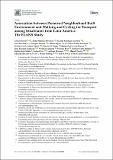Mostrar el registro sencillo del ítem
Association between Perceived Neighborhood Built Environment and Walking and Cycling for Transport among Inhabitants from Latin America: The ELANS Study
| dc.creator | Ferrari, Gerson Luis de Moraes | |
| dc.creator | Werneck, André de Oliveira | |
| dc.creator | da Silva, Danilo Rodrigues | |
| dc.creator | Kovalskys, Irina | |
| dc.creator | Gómez Salas, Georgina | |
| dc.creator | Rigotti, Attilio | |
| dc.creator | Cortés Sanabria, Lilia Yadira | |
| dc.creator | Yépez García, Martha Cecilia | |
| dc.creator | Pareja Torres, Rossina Gabriella | |
| dc.creator | Herrera Cuenca, Marianella | |
| dc.creator | Zalcman Zimberg, Ioná | |
| dc.creator | Guajardo, Viviana | |
| dc.creator | Pratt, Michael | |
| dc.creator | Cofre Bolados, Cristian Javier | |
| dc.creator | Jofré Saldía, Emilio | |
| dc.creator | Pires, Carlos | |
| dc.creator | Marques, Adilson | |
| dc.creator | Peralta, Miguel | |
| dc.creator | de Victo, Eduardo Rossato | |
| dc.creator | Fisberg, Mauro | |
| dc.date.accessioned | 2022-09-20T18:39:05Z | |
| dc.date.available | 2022-09-20T18:39:05Z | |
| dc.date.issued | 2020 | |
| dc.identifier.citation | https://www.mdpi.com/1660-4601/17/18/6858 | es_ES |
| dc.identifier.issn | 1660-4601 | |
| dc.identifier.uri | https://hdl.handle.net/10669/87382 | |
| dc.description.abstract | Purpose: This study aimed to examine the associations of the perceived neighborhood built environment with walking and cycling for transport in inhabitants from Latin American countries. Methods: This cross-sectional study involved 9218 participants (15-65 years) from the Latin American Study of Nutrition and Health, which included a nationally representative sample of eight countries. All participants completed the International Physical Activity Questionnaire-Long Form for measure walking and cycling for transport and the Neighborhood Environment Walkability Scale-Abbreviated. Furthermore, perceived proximity from home to public open spaces and shopping centers was assessed. Results: Perceived land use mix-access (OR: 1.32; 95%CI: 1.16,1.50) and the existence of many alternative routes in the neighbourhood (1.09 1.01,1.17) were associated with higher odds of reporting any walking for transport (≥10 min/week). Perceived slow speed of traffic (1.88 1.82,1.93) and few drivers exceeding the speed limits (1.92; 1.86,1.98) were also related to higher odds of reporting any walking for transport. The odds of reporting any cycling for transport (≥10 min/week) were higher in participants perceiving more walking/cycling facilities (1.87 1.76,1.99), and better aesthetics (1.22 1.09,1.38). Conclusions: Dissimilar perceived neighborhood built environment characteristics were associated with walking and cycling for transport among inhabitants from Latin America. | es_ES |
| dc.description.abstract | Instituto de Investigación Nutricional de Perú///Perú | es_ES |
| dc.description.sponsorship | Coca Cola Company///Estados Unidos | es_ES |
| dc.description.sponsorship | Hospital Infantil Sabará///Brazil | es_ES |
| dc.description.sponsorship | International Life Science Institute//ILSI/Argentina | es_ES |
| dc.description.sponsorship | Universidad de Costa Rica//UCR/Costa Rica | es_ES |
| dc.description.sponsorship | Pontificia Universidad Católica de Chile///Chile | es_ES |
| dc.description.sponsorship | Pontificia Universidad Javeriana///Colombia | es_ES |
| dc.description.sponsorship | Universidad Central de Venezuela//UCV/Venezuela | es_ES |
| dc.description.sponsorship | Universidad San Francisco de Quito///Ecuador | es_ES |
| dc.description.sponsorship | São Paulo Research Foundation/[2019/24124-7]/FAPESP/Brazil | es_ES |
| dc.language.iso | eng | es_ES |
| dc.source | International Journal of Environmental Research and Public Health; Vol. 17 Núm. 18: 2020 | es_ES |
| dc.subject | Transport physical activity | es_ES |
| dc.subject | Walking | es_ES |
| dc.subject | CYCLING | es_ES |
| dc.subject | Neighborhood built environment | es_ES |
| dc.subject | LATIN AMERICA | es_ES |
| dc.title | Association between Perceived Neighborhood Built Environment and Walking and Cycling for Transport among Inhabitants from Latin America: The ELANS Study | es_ES |
| dc.type | artículo original | es_ES |
| dc.identifier.doi | 10.3390/nu1271994 | |
| dc.description.procedence | UCR::Vicerrectoría de Docencia::Salud::Facultad de Medicina::Escuela de Medicina | es_ES |
Ficheros en el ítem
Este ítem aparece en la(s) siguiente(s) colección(ones)
-
Nutrición [253]


